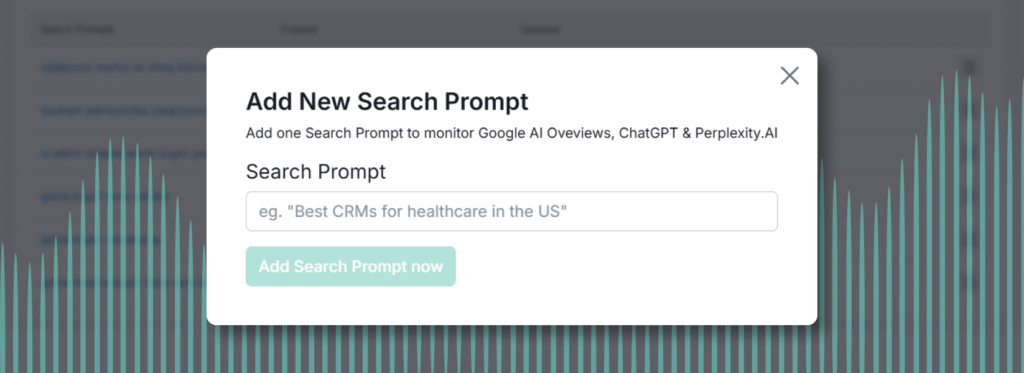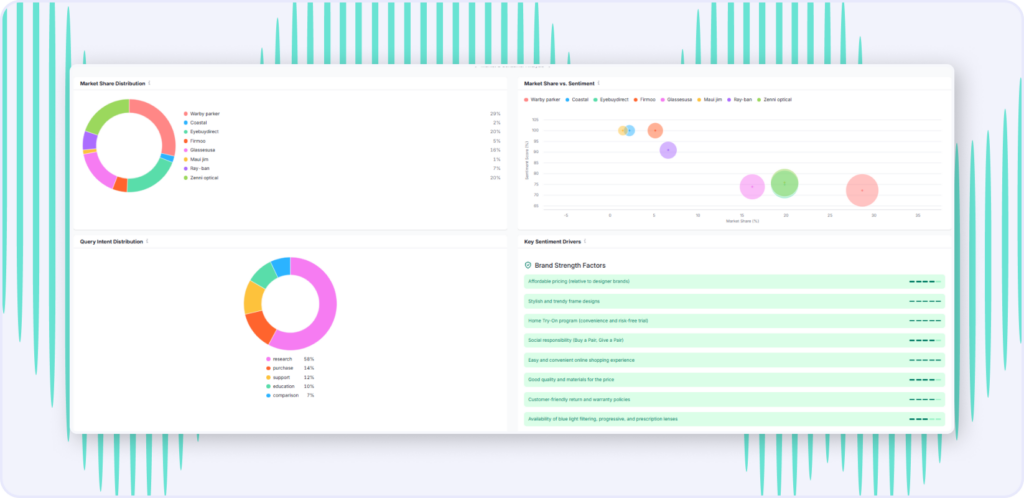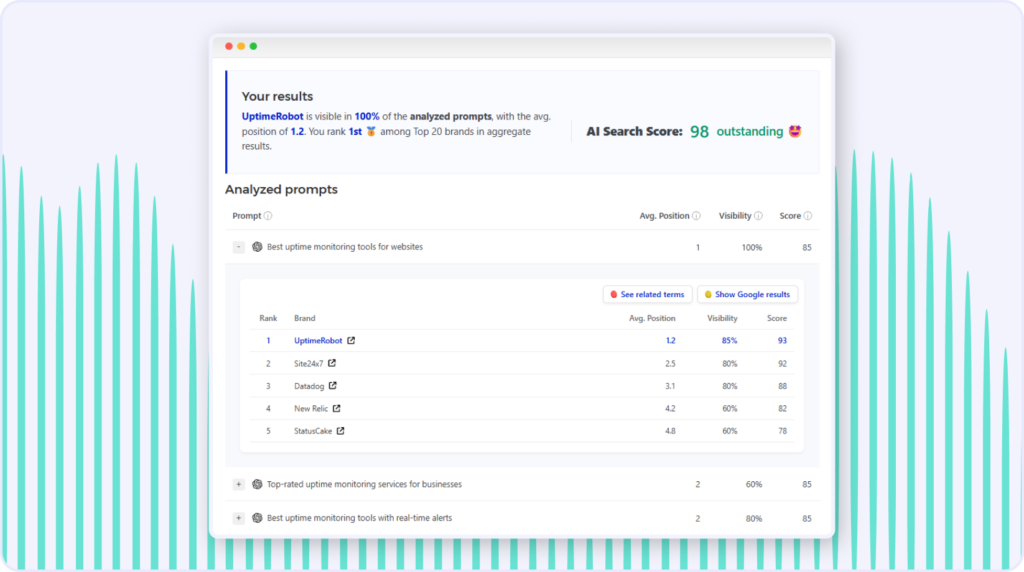Measuring success in AI Search: metrics that matter
In this article, we explain how to assess content performance in the era of AI-driven search.

Traditional SEO metrics only show part of what’s happening. AI search platforms like Google’s SGE and ChatGPT go beyond indexing – they analyze and reconstruct your content.
To remain relevant, brands must adopt new frameworks for measuring whether their content is visible, trusted, and recommended by AI systems. This article outlines how to evaluate performance effectively in the age of AI search.
Table of contents
- AI Snapshot Presence: The New Zero-Click Environment
- Citation Frequency in AI Responses: A Signal of Authority
- Share of Voice (SOV) in AI Search: Competitive Positioning
- AI Visibility Score: A Composite Metric
- Sentiment Analysis: Beyond Public Relations
- Volatility in AI Visibility: Assessing Stability
- Engagement Metrics: Post-Visibility Performance
- Thematic Relevance and Query Association: Establishing Semantic Authority
- Measuring the Impact of AI-Driven Traffic: From Discovery to Analytics
1. AI snapshot presence: the new zero-click environment
AI-generated summaries – commonly known as AI snapshots – are increasingly positioned at the top of search interfaces, often eliminating the need for users to click through to external websites. This development presents both a challenge to traditional traffic acquisition and a critical opportunity for brand visibility.
Consistent inclusion in these summaries requires more than luck. AI systems evaluate content structure, authority, and topical clarity to determine what to include.
Key actions:
- Structure content using clear H2/H3 headings and concise, query-aligned answers.
- Implement schema markup to enhance contextual comprehension by AI systems.
- Track the queries that trigger your inclusion using tools such as Otterly AI or seoClarity.

2. Citation frequency in AI responses: a signal of authority
When AI platforms reference your content, it reflects algorithmic trust. Citations in AI-generated outputs are more than symbolic; they influence which brands are perceived as authoritative sources.
However, the volume of citations is only one aspect. Context matters just as much as frequency. Citations from original research or detailed analyses carry more weight than casual mentions.
Key actions:
- Develop research-backed, authoritative content that earns organic references.
- Use brand monitoring tools to understand where and how your domain is cited.
- Evaluate citation context to ensure alignment with expertise-driven topics.

3. Share of Voice (SOV) in AI search: competitive positioning
SOV measures the proportion of visibility your brand holds relative to competitors within AI-generated content. In AI-powered search, visibility works differently than in traditional SERPs.
Understanding your relative share across key topics can reveal content gaps, identify competitive advantages, and guide resource allocation.
Key actions:
- Benchmark SOV using platforms like Profound or the Semrush AI Toolkit.
- Conduct content gap analyses to discover underrepresented topic areas.
- Monitor SOV fluctuations to measure campaign effectiveness and adjust accordingly.

4. AI Visibility Score: a composite metric
The AI Visibility Score consolidates multiple dimensions – appearance frequency, prominence, ranking position, and sentiment – into a single index. While no metric is absolute, this score offers directional insights across platforms such as ChatGPT, Bing, and Gemini.
Key actions:
- Use tools like Mangools AI Search Grader to measure platform-wide performance.
- Track score progression longitudinally to assess strategic impact.
- Investigate anomalies by correlating performance with known algorithmic updates.

5. Sentiment analysis: beyond public relations
In AI-generated content, your brand may not only be cited but also contextualized emotionally. Sentiment – positive, neutral, or negative – can influence user trust before any direct interaction occurs.
Monitoring sentiment helps align brand perception with strategic objectives and enables early intervention when negative narratives emerge.
Key actions:
- Conduct sentiment analysis across AI platforms using tools like Brandwatch or Brand24.
- Identify recurring negative framings and develop content to counterbalance them.
- Ensure consistent brand messaging, especially for high-volume branded queries.
6. Volatility in AI visibility: assessing stability
Visibility in generative AI outputs can be unstable, influenced by frequent updates to language models and shifting content interpretations. Monitoring volatility allows brands to identify potential risks and address weaknesses in content consistency or coverage.
Key actions:
- Analyze visibility trends over time to detect irregularities or drops.
- Maintain topical breadth to minimize reliance on a narrow content set.
- Respond proactively to changes in AI platform behavior.
7. Engagement metrics: post-visibility performance
While generative platforms may reduce overall click volume, the traffic they do send is typically more qualified. Measuring how users interact with your site post-click remains essential for evaluating content performance.
Insights & Actionable Recommendations:
- Segment AI-referred traffic in GA4 using custom channel groupings.
- Optimize landing pages for clarity, speed, and relevance.
- Prioritize content that demonstrates high conversion or engagement from AI-sourced users.
8. Thematic relevance and query association: establishing semantic authority
AI models rely on entity recognition and semantic embeddings to determine which sources are most relevant to a query. Brands strongly associated with specific themes or concepts are more likely to appear across a broader set of related searches.
Thematic relevance becomes essential for AI SEO. Instead of just ranking for keywords, you need to establish strong connections with your areas of expertise.
Insights & actionable recommendations:
- Build topical authority by reinforcing core entities consistently across your content.
- Use natural language processing tools to assess which entities are associated with your site.
- Focus on semantic consistency rather than keyword repetition to improve embedding-based relevance.
9. Measuring the impact of AI-Driven traffic: from discovery to analytics
AI tools like ChatGPT, Google Gemini, Bing Copilot, and Perplexity are changing how people find and interact with content. Visibility matters, but you need to track real business results.
Although GA4 does not natively isolate AI-generated referrals, custom tracking implementations can bridge this gap.
Insights & actionable recommendations:
- Use UTM parameters (e.g., utm_source=chatgpt) to track AI-originated sessions.
- Monitor referral patterns and build a dedicated channel grouping for AI sources in GA4.
- Use GA4’s Explorations feature to analyze user behavior and conversion paths from AI traffic.

Adapting for the AI-driven future
AI search changes everything. Unlike traditional search engines that simply catalog pages, AI systems actually read, understand, and reconstruct your content.
Moving fast gives you an advantage, but winning long-term means learning how AI decides what’s trustworthy and relevant. Success requires getting both the technical details and the big picture right.



